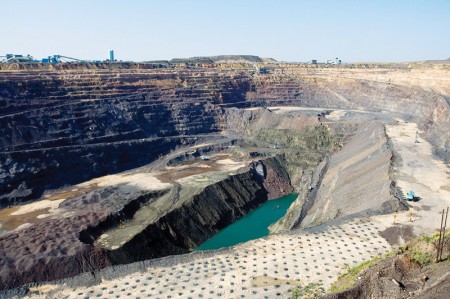The gatecrasher at Debswana's 50th birthday bash
Mbongeni Mguni | Friday June 21, 2019 13:55


The latest figures from Debswana suggest the diamond giant will stop producing the shiny stones sometime around the mid-2050s.
Should production reach that period, Debswana’s mines will be unrecognisable from what they are now. Jwaneng will most likely be an underground operation, while Orapa, if it is not also down below, will be quite larger and deeper than it currently is.
Damtshaa, the small mine near Orapa and Letlhakane discovered in 2003, will have long given up the ghost by that time, while the tailings treatment plants at Jwaneng and Letlhakane will either have already run out of their source material, or be pretty close to doing so.
This unsettling future is not breaking news for geologists and planners at Debswana. It is the reality they have lived with from the day Debswana’s first mine was commissioned at Orapa in 1971.
Diamonds are not forever. They run out, a cold inevitability that played out in 2017 when the 40-year-old Letlhakane Mine closed its doors.
Through enhanced technology, Debswana has been able to postpone the inevitable for most of its mines, over the years.
For example, Jwaneng, the world’s richest mine by value, underwent a P24 billion extension starting from 2010, deepening it to 650 metres from 410 metres. Another P15.7 billion project started this year to move from 650 metres to 830 metres in search of the shiny stones.
Debswana geologists, executives and workers live with the reality that despite these efforts, at one point or another getting to diamonds will become either too expensive or too dangerous. Or the resource, either its value or its quantity, will not justify the cost and effort of digging to reach it.
For a moment, however, on Monday, the celebration of Debswana’s 50th anniversary is an opportunity to be momentarily on something happier.
An opportunity to reflect on the miraculous story of how three shiny stones discovered on the Motloutse River in 1959, led to a multi-billion industry that quite literally built the country.
As champagne bottles are uncorked and glasses clink on Monday, no doubt the famous picture of a young Manfred Marx and his team at the site of Orapa’s discovery will flash repeatedly at a colourful ceremony.
Executives will no doubt lovingly detail how diamonds transformed Botswana from what early post-independence critics described as ‘dusty backwater’ to a progressive economy, built on a bedrock of country-spanning infrastructure by increasingly educated and experienced citizens.
“At Independence, the entire country only had 12 kilometres of tarred road, GDP per capita of about US$70 and a literacy rate below 30%,” Debswana’s lead engineer (Projects) Puso Mooketsi told a recent gathering.
“Beef accounted for about 88% of export earnings.
“The situation has changed through diamonds.”
By 2016, the total road network was measured at approximately 32,000km, GDP per capita was estimated at $6,788, amongst the highest in Africa and the literacy rate was 82% and rising.
Diamonds, the cogs on which the situation turned around, contributed 82% of total export revenues in 2016.
That is certainly worthy of a cheer at Monday’s celebrations.
Debswana’s achievements in its 50 years are incredible not only as a force for economic change, but also as a rare functioning public-private partnership between a Western and an African nation.
Such ventures are unheard of on a continent where arrangements between governments and Westerners in minerals involve extortionate stripping of raw resources for the benefit of a few greedy politicians and their equally callous partners.
Local geologists say no other company will get anywhere close to achieving what Debswana has.
This is partly because there are only four companies seriously exploring for diamonds in Botswana right now, despite the more than 50 companies holding hundreds of prospecting licences across the country.
The rest are either hamstrung by lack of funding or are holding the licences for speculative purposes, hoping to cash in by selling them on to a more serious explorer.
“Where will we be in the next 50 years?” asks Botswana Diamonds managing director, James Campbell.
“Without significant investment in exploration, where will the local diamond industry in the next 50 years be?”
Veteran diamond explorer, Leon Daniels says the trouble lies in the fact that many explorers believe simply securing a diamond prospecting licence is an achievement on its own.
“Many believe they are millionaires the moment they get the licence,” he says.
“It doesn’t work that way. You have an obligation to put money into the ground.
“You were awarded the prospecting licence because you showed you had the resources and technical capacity to explore for diamonds, so why are you not doing the work?
“Many have come to me to sell their licences.”
He adds: “Many only go as far as pitching a tent and some don’t even get to pitching the tent. At least 90% of diamond prospecting licence holders are not turning a shovel of sand on their leases.
“They are in effect sterilising the good ground that someone would be able to explore and precluding a discovery being made.”
As the celebrations of the 50th anniversary die down, the diamond industry will return to some sombre thoughts about where it is heading and how the miracle that began in Orapa can be made to last longer.
